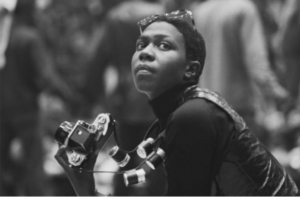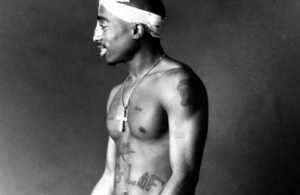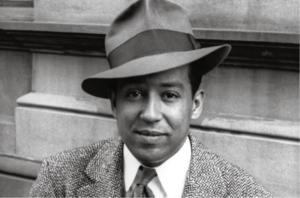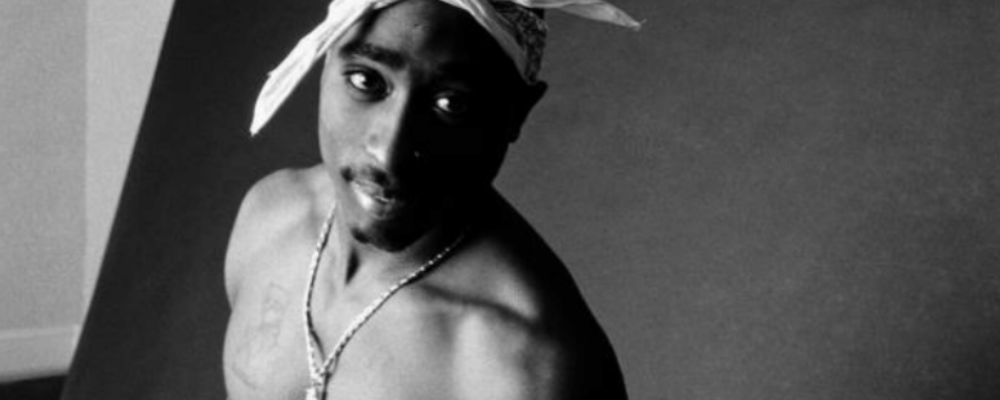The Harlem Renaissance Changed The World
“Once you wake up thought in a man, you can never put it to sleep again.” ⁃ Zora Neale Hurston
Formally known to the world as the origin of the unparalleled poetry, art and jubilant Jazz records that helped hype and heal the nation post World War I in what is now referred to as the “Harlem Renaissance” (called the “New Negro Movement” at the time by some), Manhattan’s Harlem neighborhood can’t only lay claim to the birth of one of Black America’s crowning cultural achievements but the genesis of one of Hip-Hop’s most revolutionary sons, too.
Tupac’s Rise Started in Harlem

Afeni Shakur,
Born in East Harlem in mid-1971, his mother, activist and Black Panther Party member Afeni Shakur, spent the duration of her pregnancy fighting for her own and the lives of her comrades in court for a landmark case that eventually led to a complete acquittal for all involved, proving that even as an unborn child, the life of Tupac Amaru Shakur was destined to take an extraordinary path. Although the Shakur home was one that was filled with affection (and radical teachings fueled by the family’s ties to the party), it was often met with financial insecurity, leading to a young Tupac being forced to make different homes in different cities. One of those cities being Baltimore, MD, the site of the Baltimore School for The Arts, a site that in 1986 would ultimately come to incite and shape the rousing performer that Shakur would later become in his final years.
As a student (alongside fellow alumni like Jada Pinkett-Smith), Tupac developed a taste for writing, ballet, rapping, and acting. Sadly, his time in Maryland would be cut short as he changed locations yet again in 1988 but unbeknownst to him, Afeni and his younger sister Sekyiwa, Marin City, CA (a small working-class community near San Francisco) would be both his new residence and subsequent good luck charm. After attempting to make a living on the streets selling drugs to the city’s inhabitants (and failing to do so due to his guilt), Tupac decided to instead follow his talents for entertaining audiences and commit to establishing a career in the music industry. Through his relationships in Marin, Tupac would soon be introduced to rising rap stars’ Digital Underground in 1990. Serving as a hype-man, backup dancer and occasional guest vocalist on tour and tape, Tupac (through his supporting role) was able to get his first glimpse of life as an artist and his first taste of success appearing on the group’s 1991 US Dance chart hit ‘’Same Song”. Within a few months he would go on to release his own work, the full-length solo album “2pacalypse Now”. Featuring the standouts “Brenda’s Got A Baby” & “Trapped”, “2pacalypse Now” was a rough and rollicking but equally thought-provoking excursion.
Whilst arguably coarse in comparison to the numerous juggernauts that were yet to come, “2pacalypse Now” would set the tone for the rest of his discography, thematically, sonically and lyrically. The 55 minute long collection runs the gamut in terms of topics, ranging from social upheavals to drug addiction, teen pregnancy, incarceration and isolation, topics that no doubt by the early 1990s had already become fixtures of the roughly two-decade-old genre but where the up-and-comer‘s predecessors had excelled in giving the block a successful and animated soundtrack, Tupac excelled in giving that same soundtrack its soul. A voracious reader since boyhood, the rapper was undoubtedly known for aligning himself with the preeminent producers of the era (Daz Dillinger, Dr. Dre, Shock G, Digital Underground, and the legendary Jam Master Jay just to name a few) but his words would always come first. Exceptionally pensive, he turned to his lyrics for consolation in times of doubt. Forthright and passionate, his verses chronicled and put a fierce spotlight on the trials and tribulations of the hood’s Black teens and 20-somethings, frequently cycling back and forth between sage big brother figure(“Words Of Wisdom”) and tragic anti-hero desperately in need of an authority figure to call his own (“Soulja’s Story”).

Tupac
The controversy surrounding the sales of “2pacalypse Now”, its turbulent themes and frequent portrayals of police brutality propelled Tupac into the limelight virtually overnight and by the March 1995 launch of his third record “Me Against The World”, he had transitioned from gutsy personality on the rise to outright phenomenon with one piece in particular capturing the public’s attention.“Dear Mama” hit airwaves that February and immediately became an anthem for the plight of single mothers and their children worldwide. A brooding, sincere and sentimental tribute to his mother, the tune was the perfect vehicle to relay the gravity of an album that was every bit as much a starkly somber post-prison confessional as it was a commercial blockbuster. “Me Against The World” would debut at #1 and further cement his status as the 1990s’ premier Rap lyricist. Focused on articulating complex emotions and accessible spiritual imagery versus complicated wordplay and delivery, Tupac won his ardent admirers through his ability to take the narrative of the Black man away from a press ravenous to wreak havoc in the aftermath of the Crack Epidemic and L.A. Riots of the 1980s and early‘90s and give it back to its rightful owner: the Black man himself.
“So Many Tears” finds the rapper battling the repercussions of his actions and their toll on his mental health while “Young Niggaz” serves as a warning for young Black men enamored with gang violence. Title track “Me Against The World” sees a contemplative Shakur recall the chilling conditions in which he had once lived, question whether those conditions were even capable of being thoroughly overcome and wrestle with the sinking feeling that he isn’t as popular as it seems whilst the solemn but defiant “Death Around The Corner” tells the tale of an emcee gripped with paranoia, quick to forecast his own untimely death with an eerie accuracy in an almost taunting manner, as if to say to his rivals that even cold-blooded murder couldn’t and wouldn’t keep the man and marvel down.
And unfortunately, his premonitions were right. On the night of September 7th, 1996, just steps away from the MGM Grand Las Vegas and less than seven months since his fourth LP “All Eyez On Me” had swept the charts, the 25-year-old luminary was brutally gunned down by an unknown assailant. He would succumb to his extensive injuries on the evening of September 13th at the University Medical Center of Southern Nevada. Dozens of theories on exactly who and what happened that night still abound now in 2019 but still, no concrete answers have been given. His fans, friends, and family continue to mourn but luckily, he would leave behind a staggering body of work that would only continue to grow and offer solace as time went by. The first of many posthumous classics that would hail from his estate was “The Don Killuminati: The 7 Day Theory” in November of 1996, home to crowd favorites “Hail Mary”, “Toss It Up” and an ode to his beloved city “To Live And Die In L.A.”. Next in 1997 would come “R U Still Down? (Remember Me)”, 1998 would see the spellbinding double-disc “Greatest Hits” featuring the Grammys-Nominated opus “Changes” but 1999 would see both the end of the millennium and possibly one of his best anthologies to date.
Unleashed on December 21st, “Still I Rise”, the long-awaited collaboration with his crew The Outlawz (which found its formation when Shakur returned from a stint at the Clinton Correctional Facility in 1995), consisted of 15 songs recorded and remixed using unreleased verses from the late rapper’s lengthy repertoire. Although it undoubtedly received no direct input from Shakur himself, the project quickly zeroed in on what made him, the man and artist, tick. An unapologetic love-letter to the West Coast (and starring one of its defining voices no less), “Still I Rise”expertly cascades hard-bitten rhymes with glossy hooks and laidback beats, transporting the listener(no matter where they may be) to the proud sunny strips of urban Los Angeles, with no other track channeling their spirit more-so than the Nate Dogg-assisted“Teardrops And Closed Caskets”. A woeful saga about the deadly antics of three wayward youths named Precious, Lil’ Mo and Young Trigga, describes the gory details of a teenaged love affair gone horribly wrong but displays an astonishing warmth whilst doing so, reminding us that Tupac would always be there to bring comfort to those who needed it most and as luck would have it, a second (and equally pivotal) compilation would come from his estate in late1999. “The Rose That Grew From Concrete” arrived in stores on November 1st and bore a bevy of poems written by an adolescent Tupac from years 1989 to 1990. Earnest and benign, selections like “When I Do Kiss U”, “Carmencita of the Bronx! (Dedicated to Carmen)”and“Black Woman: 4 Marquita” foreshadowed the spirited (and prolific) penman that would emerge in full effect on 1991’s epic “2pacaplyse Now”. All in all, at the heart of the vast majority of Shakur’s work, laid a staunch and razor-sharp duality, even when the emcee angrily fantasized about enacting revenge on his former friends and perceived foes, there was still apart of him that yearned for a better today and tomorrow for both he and his enemies. More simply put: at the heart of the vast majority of Shakur’s labor laid an immense (and captivating) vulnerability. This vulnerability not unlike the vulnerability shown by another prominent BlackAmerican icon whose compositions took him to similarly hallowed heights in Harlem just a mere seven decades prior.
Following In The Footsteps Of Greatness

Langston Hughes
Graduating from high school in June of 1920 in Columbus, OH, James Mercer Langston Hughes would find himself spending his first summer as an adult in Mexico with his estranged father attempting to reconnect and secure funds for tuition to attend the college of his dreams: Columbia University in New York, NY. A wordsmith since elementary school, Hughes was invigorated by the culture and relative freedom of nearby Harlem and his career began to flourish when he published the poem “The Negro Speaks of Rivers” is the official magazine of the NAACP entitled “The Crisis” and although there were several notable names archiving Black thought during this period (the aforementioned Hurston herself was a close friend of his), Langston stood out due to his devotion to faithfully portraying the tender realities of every day Black Americans, their struggles, their strengths, their character flaws, and their heroism. His unique style and love of all things Jazz would lead to the creation of a genre called Jazz poetry, whose intricate rhythms, lush melodies and emphasis on sound and improvisation, many believe is a direct precursor to what we now recognize as Rap. Following further groundbreaking poems, columns, plays, and novels throughout the‘20s, ‘30s, ‘40s, ‘50s and early ‘60s, Hughes was laid to rest at the age of 65 in 1967 but his creative mastery and keen insights on a historically misunderstood and maltreated population would live on well beyond his days.
And not only would Hughes go on to shape and inspire the minds of multiple generations of readers around the world but he would go on to indirectly shape and inspire perhaps the most courageous minds (and movements) of them all. A fan, ally and mutually trusted confidante of Mr. Hughes, Dr. Martin Luther King Jr.’s leadership of and campaigning for the American CivilRights movement helped usher in an unprecedented wave of political ideas and autonomy. More and more domestic media coverage was being devoted to urgent issues of social justice including(but not limited to)the often dire consequences of racial discrimination, bias, and class warfare. Multiple schools, parties, and factions had begun their ascent to national prominence with the most divisive of those being the much-publicized Black Panther Party founded in Oakland, CA in 1966. Whilst Dr. King’s robust speeches and sermons on peace, brotherhood, and fairness (which allegedly contained copious references to his comrade Hughes’ catalog) struck a monumental chord with tens of millions of citizens across the country and encouraged them to conceptualize color lines in a radically new way, there were also millions more who wanted to know just how that peace and brotherhood could be adequately obtained in the United States of America when the very notion of American Whiteness was dependent upon the subjugation of American Blackness. Advocates and rebels like Huey P. Newton, Kathleen Cleaver, and Angela Davis appeared in newspapers and on television screens throughout the late ‘60s and the early ‘70s spreading their message of Black Liberation near and far causing membership to surge well into the thousands in places like Chicago, Philadelphia, Seattle, Southern California and New York City where a young woman and writer by the name of Afeni had lived.
A Modern Renaissance
Awash with museums, galleries, concert halls and exhibits commemorating the contributions of Black American art (past and present), the vibrancy of Modern-day New York City is unquestionably a testament to the profound impact and enduring legacy of its extraordinary renaissance and the tour de force talent that is produced. Once a sterile sanctuary for upper-class White Americans, Harlem is now a multicultural mecca virtually unrivaled elsewhere in the 50 states and the source of a scribe and musician that too has remained virtually unrivaled. Fiery, fraught, rambunctious and righteous, in many ways Tupac Shakur led the charge on a renaissance of his own, climbing to heights thought unimaginable for a rapper and refusing to do anything less than bring the rest of the ghetto with him on his mission to the top. The very same mission shared by Claude McKay when he penned “If We Must Die” a rousing literary rebuke of the racist brutality that had engulfed the U.S. in what would be referred to as the“Red Summer” in 1919. The very same mission shared by painter Aaron Douglas whose murals’ modernist fusion of African history and Black American ethos changed the way our communities were seen, discerned and drawn and the very same mission that drove Bessie Smith to dutifully sing of a poor man’s blues. The very same mission that Langston Hughes was on when he spoke of the mighty rivers that his soul had grown to mirror in 1921.
Today, the sheer scale and global dominance of contemporary Hip-Hop may be novel to some but its roots and roads are long and winding. From the visionaries of the Bronx to the vast riches that hailed from Brooklyn, from the unavoidable to the unsung, the unlucky and the untouchable. From the insurgents to the loyalists, the indifferent, the pearl knights and the ne’er-do-wells, Hip-Hop has left behind a trail of triumphs, tragedies and titans like Tupac Shakur in its wake but for all intents and purposes, those roads have always had a little habit of leading back to a little place in the city of dreams called Harlem.

